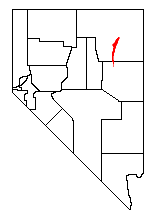This article needs additional citations for verification. (June 2024) |
| Ruby Mountains | |
|---|---|
 Peaks around Ruby Dome | |
| Highest point | |
| Peak | Ruby Dome |
| Elevation | 11,387 ft (3,471 m) |
| Coordinates | 40°37′18″N 115°28′31″W / 40.62167°N 115.47528°W[1] |
| Dimensions | |
| Length | 80 mi (130 km) North-South |
| Width | 11 mi (18 km)[2] |
| Geography | |
| Country | United States |
| State | Nevada |
| County | Elko |
The Ruby Mountains (Shoshoni: 'Duka Doya', meaning “Snowcapped”)[3] are a mountain range, primarily located within Elko County with a small extension into White Pine County, in Nevada, United States. Most of the range is included within the Humboldt-Toiyabe National Forest.[4] The range reaches a maximum elevation of 11,387 feet (3,471 m) on the summit of Ruby Dome.[5] To the north is Secret Pass and the East Humboldt Range, and from there the Rubies run south-southwest for about 80 miles (130 km). To the east lies Ruby Valley, and to the west lie Huntington and Lamoille Valleys. The Ruby Mountains are the only range of an introduced bird, the Himalayan snowcock, in North America. The mountain range was named after the garnets found by early explorers.[citation needed] The central core of the range shows extensive evidence of glaciation during recent ice ages, including U-shaped canyons, moraines, hanging valleys, and steeply carved granite mountains, cliffs, and cirques.[citation needed]
- ^ "Ruby Dome Cairn". NGS Data Sheet. National Geodetic Survey, National Oceanic and Atmospheric Administration, United States Department of Commerce. Retrieved 4 September 2022.
- ^ "Backpacking In The Ruby Mountains". Retrieved 1 June 2010.
- ^ Unlimited, National Wildlife Federation, Rocky Mountain Wild, and Trout (14 June 2022). "Little Potential for Development, High Potential for Harm". ArcGIS StoryMaps. Retrieved 12 November 2023.
{{cite web}}: CS1 maint: multiple names: authors list (link) - ^ "Humboldt-Toiyabe National Forest: Ruby Mountains Wilderness". USDA Forest Service. Retrieved 4 September 2022.
- ^ "Ruby Dome, Nevada". Peakbagger.com. Retrieved 19 May 2011.
